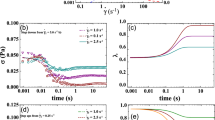Abstract
The micromorphic theory of Eringen is applied to study the tube flow of blood. The blood is considered to be a deformable suspension, with constitutive relations of the form of those of simple microfluids. By means of energy consideration, a relation is established between the local concentration parameter and the measure of rotationality involving both macro-and micromotions. The tube flow problem is then solved with some analyses on viscosity coefficients and boundary conditions. The results obtained indicate an integrated explanation of various important physical phenomena associated with blood flow, such as the tube size dependence of the apparent viscosity and the non-uniform concentration distribution over a tube cross section.
Similar content being viewed by others
Literature
Acre, E. L., A. N. Bulygin and E. V. Kuvshinskii. 1965 “Assymetrie Hydromechanies,”PMM,29, 297–308.
Ariman, T. 1971. “On the Analysis of Blood Flow.”J. Biomech.,4, 185–192.
Barbee, J. H. and G. R. Coeklet. 1971. “Prediction of Blood Flow in Tubes with Diameters as Small as 29 Microns.”Microvascular Res.,3, 17–21.
Batchelor, G. K. 1967.An Introduction to Fluid Dynamics. Cambridge University Press.
—— 1970. “The Stress System in a Suspension of Force-Free Particles.“J. Fluid Mech.,”41, 545–570.
Bretheron, F. P. 1962. “The Motion of Rigid Particles-Shear Flow at Low Reynolds Number.”J. Fluid Mech.,14, 284–304.
Bugliarello, G. and J. Sevilla. 1970. “Velocity Distribution and Other Characteristics of Steady and Pulsatile Blood Flow in Fine Glass Tubes.”Biorheology,7, 85–107.
Charm, S. E., G. S. Kurland and S. L. Brown. 1968. “The Influence of Radial Distribution and Marginal Plasma Layer or the Flow of Red Cell Suspensions.”Biorheology,5, 15–43.
Cowin, S. C. 1972. “On the Polar Fluid as a Model for Blood Flow in Tubes.”Biorheology,9, 23–25.
Dix, F. J. and F. W. Scott Blair. 1940.J. Appl. Physiol.,11, 574.
Eringen, A. C. 1964. “Simple Micro fluids.”Int. J. Engng. Sci.,2, 205–217.
——. 1966. “Theory of Mieropolar Fluids.”J. Math. Mech.,16, 1–18.
—. 1967. “Mechanics of Mieromorphie Continua.”Mechanics of Generalized Continua (Ed. E. Kröner), Springer-Verlag, pp. 18–35.
——. 1970. “Balance Laws of Micromorphic Mechanics.”Int. J. Engng. Sci.,8, 819–828.
——. 1972. “Micromorphic Description of Turbulent Channel Flow.”J. Math. Analysis Applic.,39, 253–266.
—— and E. S. Suhubi. 1964. “Nonlinear Theory of Simple Micro-Elastic Solids.”Int. J. Engng. Sci.,2, 189–203.
Giesekus, H. 1962. “Stromungen mit Konstantem Gesehwindigkeitsgradienten und die Bewegung von darin suspendiertin Teilchen.”Rheol. Acta.,2, 101–122.
Goddard, J. D. and C. Miller. 1967. “Nonlinear Effects in the Rheology of Dilute Suspensions.”J. Fluid Mech.,28, 657–673.
Goldman, A. J., R. G. Cox and H. Brenner. 1967. “Slow Viscous Motion of a Sphere Parallel to a Plane Wall.”Chem. Engng. Sci.,22, 637–652.
Goldsmith, H. L. and S. G. Mason. 1967.Rheology,4, 85.
Happel, J. and H. Brenner. 1965.Low Reynolds Number Hydrodynamics. Prentice-Hall.
Haynes, R. H. 1961.Soc. Rheol. Trans.,5, 85.
Houssay, B. A. 1955.Human Physiology, McGraw-Hill.
Kirwan, A. C. and M. S. Chang. 1970. “Cylindrical Flow of a Fluid Containing Deformable Structures.”Int. J. Engng. Sci.,8, 731–741.
Kuroda, D., Y. Mishiro, I. Wada and J. Tokushima. 1958.Expl. Med.,4, 73.
Landau, L. D. 1959.Fluid Mechanics, p. 69.
Mason, S. G., H. Brenner and C. E. Chaffey. 1965.Rheol. Acta,4, 65.
Scott-Blair, G. W. 1958. “The Importance of the Sigma Phenomenon in the Study of the Flow of Blood.”Rheol. Acta.,1, 123–126.
Segré, G. and A. Silberberg. 1962. “Behaviour of Macroscopic Rigid Spheres in Poiseuflle Flow.”J. Fluid Mech.,14, 115–157.
Seshadri, V. and S. P. Sutera. 1968. “Concentration Changes of Suspensions of Rigid Spheres Flowing Through Tubes.”J. Colloid Interface Sci.,27, 101–110.
Truesdell, E. 1960.Handbuch der Physik III/1,363.
Vand, V. J. 1948. “Viscosity of Solutions and Suspensions.”J. phys. Chem.,52, 277–321.
Wayland, H. 1967. “Rheology and the Microcirculation.”Gastroenterology,52, 342–355.
Author information
Authors and Affiliations
Rights and permissions
About this article
Cite this article
Kang, C.K., Eringen, A.C. The effect of microstructure on the rheological properties of blood. Bltn Mathcal Biology 38, 135–159 (1976). https://doi.org/10.1007/BF02471753
Received:
Revised:
Issue Date:
DOI: https://doi.org/10.1007/BF02471753




